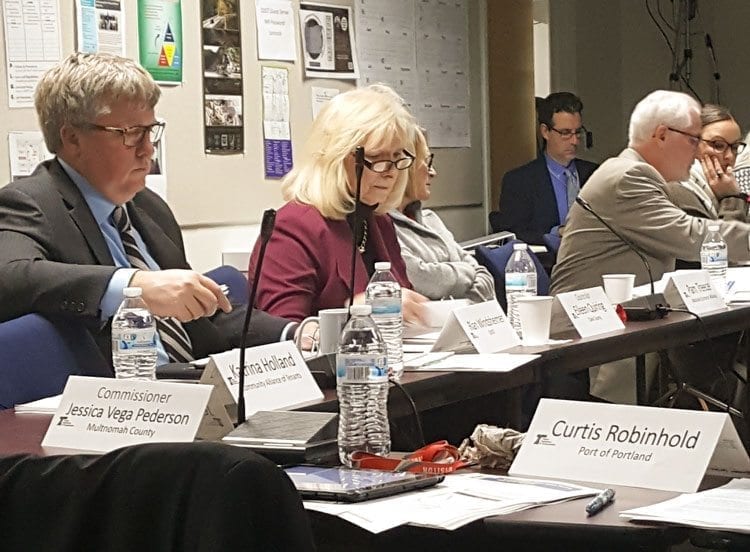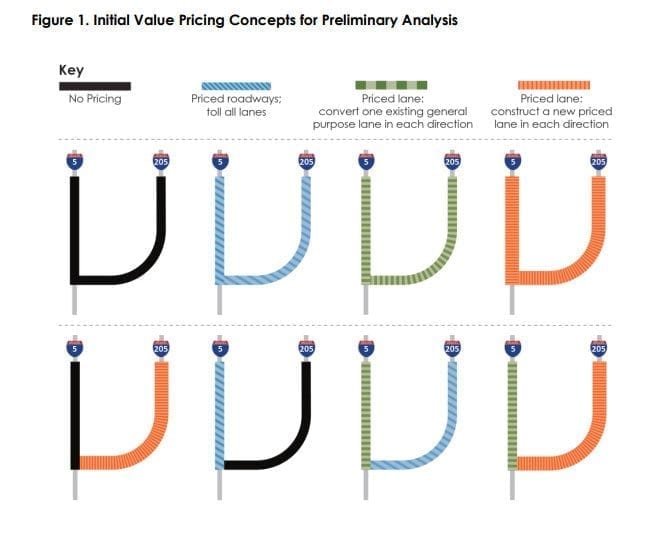Portland Region Value Pricing Policy Advisory Committee holds second of six meetings
Brook Pell
For ClarkCountyToday.com
PORTLAND — If you are a Clark County resident who commutes into Oregon via I-5 or I-205, there is no doubt you have experienced the frustrations of an overloaded freeway system.
Oregon lawmakers have offered their vision for a solution and it’s spelled out in Section 120 of House Bill 2017 that was signed into law on Aug. 18 and went into effect on Oct. 6 of this year.
Buried about two-thirds of the way into the 146-page bill, on pages 106 and 107, the specific details of the lawmakers’ vision is shared. The vision is that Oregon can reduce congestion on the freeways by implementing “value pricing” tolls that begin “on Interstate 205, beginning at the Washington state line and ending where it intersects with Interstate 5 in this state” as well as “on Interstate 5, beginning at the Washington state line and ending where it intersects with Interstate 205.”
Video courtesy of Oregon Department of Transportation
On Thursday, the Portland Region Value Pricing Policy Advisory Committee held its second of six meetings regarding that tolling plan. The committee is charged with the task “to guide ODOT throughout the value pricing feasibility analysis,” according to Oregon.gov. The end goal: “to seek approval from the Federal Highway Administration (FHWA) by December 2018 to implement value pricing on the I-5 and I-205 corridors.” That means tolling.
The committee consists of 25 members who represent a variety of interests and perspectives from around the Portland-Vancouver metro region. Of those 25 members, Anne McEnerny Ogle — City of Vancouver Mayor Elect, Eileen Quiring — Clark County Councilor, and Kris Strickler — Washington Department of Transportation (WSDOT) are the voices among the committee representing Southwest Washington.
At the beginning of the meeting public comment was allowed, and there were noteworthy comments made by frustrated citizens who wanted to be sure the committee knew they felt tolling I-5 and I-205 was not the answer to alleviate a burdened system that most strongly believe should have been overhauled decades ago.


First up for comment was Camas resident John Ley.
“I would hope you would ask the question and keep it at the core of everything you do for the next six months. Where’s the value for the average citizen?” Ley told the members of the committee. “How many new lanes need to be added to decongest current roads and highways?”
In Oregon’s current Traffic Congestion Relief Program there are not any plans to add additional lanes to the congested corridors, even though those would be used for tolling purposes if the feasibility analysis deems necessary.
“I am here to contest the tollways; I am here to see if I can stop it in its tracks,” said area resident James Fransen. “The reason being, I have seen too much corruption. Congestion pricing is an oxymoron. All you are going to do is increase congestion, drive the public off of the tollways and onto the private streets — create more wear and tear.”

Fransen went on to point out that tolls had worked in San Diego with the Coronado Bay Bridge only because once the bridge was paid for the tolling ceased.
The majority of the meeting was spent understanding the timeline and reviewing the initial concepts for evaluation. Currently there are three pricing treatments proposed with multiple-mixed variations possible.
The priced roadway option would toll all lanes of the interstate and add no new lanes, There are two variations to the following priced lane treatment, either utilize an existing lane and toll that lane or construct a new lane that would be tolled. With either priced lane options, the idea is that those who wish to travel from point A to point B in a faster rate would pay the toll to travel in the less-congested lane.
From three treatment options, there are multiple variations to be considered — meaning just because I-5 is a priced roadway does not mean I-205 has to be as well.
The committee also spoke about getting input from the public and Quiring said after the meeting, she is already working on ways to reach constituents in and around Clark County to get their input.
The committee is planning to hold several public town halls and informational social media campaigns to help educate area residents on value pricing tolls.
The next Portland Region Value Pricing Policy Advisory Committee meeting is scheduled for Feb. 28 at 2-5 p.m. at the ODOT Region 1 Office 123 NW Flanders St., in Portland.
For further information the committee website can be accessed by clicking here.




